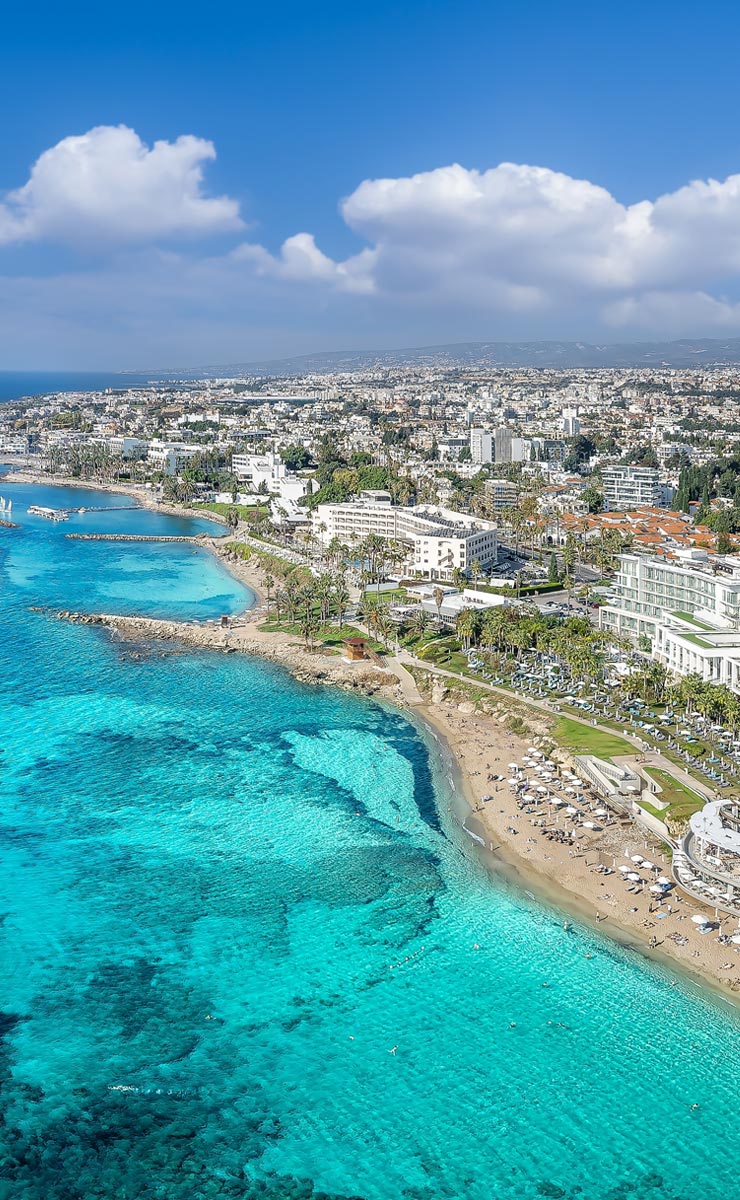First and foremost, Paphos is famous as the birthplace of Aphrodite, the goddess of erotic love and beauty. Her story is a classic, graphic example of the earthiness of Greek myth, which routinely deals with themes such as rape, infidelity, murder, trickery, and even cannibalism. Which is as it should be, if your gods are all too human in their attributes.
In the Theogony by Hesiod (7th century, BC), we find the most popular story of Aphrodite's birth, involving an act that can be added to the list above: castration. The pre-Olympian Titan, Cronus, castrated his father, Uranus, and tossed his genitals into the sea off the coast of Cyprus at Paphos. Out of the resulting foamy turbulence there emerged the most beautiful female in history. The wind carried Aphrodite to the shore of Paphos as she stood on an open oyster shell, as portrayed in the famous painting. The Birth of Venus, by Sandro Boticelli in 1486.
There are other versions of Aphrodite's story- Homer says she had Zeus and the Titaness Dione for parents, Plato says that both stories are true, and refer to two different aspects of Aphrodite: one more earthy, and of the people (Aphrodite Pandemos), the other more idealized, and heaven-centered, with a de-emphasis on physical desire (Aphrodite Urania).
At any rate, Paphos, on Cyprus's southwest coast, became the Mediterranean world's major cult center of Aphrodite worship. In the Odyssey, Homer mentions the sanctuary and altar of Aphrodite at Paphos, which is where "laughter-loving Aphrodite" fled to after being caught committing adultery with Ares, the god of war, by her husband, the morose, lame and ugly Hephaestus (god of volcanoes and iron work.
In antiquity, Paphos occupied two sites: Old Paphos and New Paphos. New Paphos (pop 31,000, 61,000 metro) is the modern, currently inhabited city. Old Paphos is about 14 km southeast, along the coast, as is Aphrodite's Rock, part of a sea stack (columns of rock created by wave action on a headland), and traditional birthplace of Aphrodite.
Old Paphos, near the present day village of Kouklia, is on a 130m rise of land 1.5km inland from the sea. Kouklia has a small archeological museum a little northwest of the village, featuring finds from the nearby ruins of the magnificent, Mycenaean-era (12th century BC) temple to Aphrodite and a necropolis. This was the temple which made Paphos the principal place of Aphrodite worship in the Mediterranean world. Since 1980 both Old and New Paphos form a UNESCO World Heritage site.
Hotels in Paphos
Family friendly Leonardo Laura Beach and Splash Resort on the west coast of Cyprus has one of the largest on campus water park on the island, a spa, a gym, several pools, lots of meal choices, and tons of things to keep the young ones occupied
Louis Hotels’ King Jason Paphos is a 4-star, adults-only hotel and resort in Paphos, southwest Cyprus, population 90,000
Ideally situated a few meters from the beach, family-friendly Leonardo Cypria Bay has it all; a huge, grotto-like freeform swimming pool, extensive greenery, a first class spa, 293 rooms, suites, and swim-up rooms, great food, and a full slate of activities for kids and adults alike
History
The link between Paphos and Aphrodite goes back to the settlement's founding; Paphos was the son of Pygmalion, the mythical Cypriot sculptor who carved a cult image of Aphrodite that was incredibly lifelike. The 1st century, AD encyclopedia of myths called Bibliotheke states that Pygmalion had such a high level of devotion to the goddess that he removed the statue from its place in the temple, took it home for safekeeping, and put it on his couch. There the spirit of Aphrodite entered the statue, brought it to life, and eventually bore 2 children to Pygmalion: Paphos, and a daughter, Metharme.
Cinyras, who was either the son of Paphos, or his brother in-law, founded the ancient city with Aphrodite as its patron deity.
Archeological evidence tells us that people had been living in Old Paphos since the Neolithic period (around 4,000 BC), with evidence of human inhabitation in New Paphos pre-dating the Christian era by several centuries, thus making the term “new” a little bit of a misnomer. The ruins of New Paphos comprise what is now called the Paphos Archeological Park, a 10 meter-high hill on a headland just north of the town marina and harbor and containing extensive ruins.
During the Hellenistic era, New Paphos became the capital of Cyprus. The Apostle Paul and his traveling companion Barnabas, a Cypriot, stopped at Paphos during Paul's first missionary journey around 55 AD. They had first landed at Salamis, on the east coast (now in occupied Turkish Cyprus), and traveled throughout the island, preaching in local synagogues along the way. Sergius Paulus, the Roman proconsul (governor) of Cyprus, who lived in Paphos, sent for Paul and Barnabas, desiring to hear their message. It was during this meeting that a Jewish false prophet named Bar-Jesus, who was known by the proconsul, tried to turn Sergius Paulus away from Paul's message. Acts chapter 13 says that Paul, "filled with the Holy Spirit," struck Bar-Jesus temporarily blind as proof of the truth of his message. As a result of this "power encounter," Sergius Paulus was converted to Christianity.
New Paphos, or Nea Paphos, was said to be founded by Agepenor, king of Arcadia on mainland Greece, and one of the men who had hid inside the Trojan horse. He picked a site on the sea with a good natural harbor. Second century, AD Greek historian and geographer Pausanias says that Agepenor was blown off course during his return from Troy and was shipwrecked at Paphos. Fifth century, BC historian Herodotus mentions an Arcadian colony on Cyprus. Nea Paphos was also a center for cultic worship of Aphrodite, and had built several temples in her honor, although it never superseded Old Paphos's importance in that respect.
After the Roman era the seat of government on Cyprus was moved to Salamis. The following centuries saw continued decline for the port and city up to and during the British colonial period which started in the 1880's and ended in 1960.
The events during 1974, when the Turks seized northern Cyprus and a wholesale exodus of Greeks from the northern third of the island ensued, gave impetus to sudden growth in Paphos, where many of the refugees resettled. A number of public works and infrastructure projects were completed, including improved water distribution, roads and Cyprus's 2nd international airport.
A number of resorts were built in the 1980's and '90's to handle increased tourist traffic. A number of improvements were made along the seafront promenade approaching the marina, and a long seafront path covering several kilometers was built.
Worth Seeing
Nea Paphos is in its turn divided into 2 sections; Paphos, on a rise 100 meters high which overlooks the second section, Lower or Kato Paphos, along the Mediterranean seashore.
The Castle and Harbor
At the approximate center point of the coastline of Kato Paphos a triangular-shaped headland juts about a kilometer into the sea. The Paphos Harbor and Marina, tiny at about 200 X 200m, nestles in the waters on the headland's south side, protected by the intervening rise to the north. The Coastal Boardwalk, coming out of the south, skirts the Marina and continues, wrapping around the headland and then bending north, terminating at the Elysium resort, about 500m north of the headland. Along the walk are all kinds of places to eat, shop and browse, along with plenty of cafes to sit, sip coffee, eat a snack, and watch people. Tied up at the Marina are various boats offering such activities as deep sea fishing, scuba diving lessons, and glass bottom boat tours.
Just west of the harbor, at the beginning of the harbor mole, which also serves as a parking lot, is the Paphos Castle, originally built during the Byzantine era as the chief defensive fortification of the town. During the 13th century an earthquake destroyed it, and it was rebuilt. Then the Venetians dismantled it in 1570. It was rebuilt again by the Ottomans. It has been used, in addition as a defensive fortification, as a prison, and by the British as a salt warehouse. It is now used annually in September during the Paphos Cultural Festival.
Paphos Archeological Park
The headland, just north of the castle and harbor, is completely undeveloped, with all of its area given over to ongoing excavations of the Paphos Archeological Park. Main excavations began in 1962 by the Greek Department of Antiquities and uncovered several private residences, administrative buildings, and religious buildings.. The Park is a network of several major archeological sites with connecting footpaths. The single, unifying feature of the park's various sites are its really exceptional floor mosaics, which are some of the best preserved mosaics in the world dating from the early centuries of the Christian era. An interesting feature of these mosaics is that the names of the gods and people depicted are often worked into the mosaic structure, providing easy identification of their subjects.
Highlights of the Park include the House of Dionysus, a restored Roman villa from the 2nd century, AD. The villa is so-named because of the repeated motif of Dionysus, god of wine and revelry, in its floor mosaics, including a Dionysiac procession. The owner of the villa was likely a wealthy Paphian, or perhaps a Roman ruler who liked to party. The House of Theseus, near the House of Dionysus, is also from the 2nd century AD. Its mosaics use geometric patterns and scenes from mythology, including the "Bath of Achilles" and "Theseus killing the Minotaur," which is a circular mosaic with Theseus in its center. The surrounding elaborate design is meant to represent the Labyrinth.
The House of Aion, named for the focal subject of its main mosaic (Aion, a product of the syncretism which developed after the introduction of Christianity, was a supreme being above all other gods), is near the previously mentioned houses. Its main mosaic has 5 panels which adorn the floor of what was possibly a large reception room. Themes of these beautifully preserved mosaics include Hermes handing baby Dionysus to his tutor while nymphs prepare the baby's bath, the beauty contest between Cassiopeia and the Neraides or Nymphs (with Helios, Zeus and Athena observing from above the scene), a procession of Dionysus depicting the god's inauguration as a deity, and a music competition between Marsyas and Apollo (Marsyas, a human who thought he could play better than Dionysus, begs for his life after losing.) The most famous and well-preserved mosaic depicts the story of Leda and the Swan, where Zeus, in the form of a swan, seduces the beautiful mother of Helen of Troy. Thematically, all these mosaics are thought to be linked, showing a progression of Dionysus's life.
The House of Orpheus dates around the beginning of the 3rd century, AD. Its Greco-Roman layout is similar to the other 3 houses mentioned, with a central courtyard surrounded by and walled off from the street by rooms. The house is only partly excavated, but some impressive mosaics have been uncovered. These include Orpheus and his Lyre, Hercules and the Lion of Nemea, and The Amazon. Orpheus was known for his ability to cast a spell on his listeners with his music, which is why the mosaic shows him surrounded by mesmerized animals as he plays. The first of Hercules' 7 labors was to slay a lion terrorizing the region of Nemea. As for the Amazon, she is depicted standing in front of her horse, which is a little unusual since most likenesses of Amazons have them riding their horses.
Other noteworthy structures in the Archeological Park include the ruins of a Byzantine castle known as the Saranta Kolones (Forty Columns). The name comes from the granite columns scattered across the site. Built in the early 13th century on the ruins of a previous castle, it was almost immediately brought down by an earthquake, in 1222. Parts of the walls are still standing, as well as the arch at its entrance. The Ancient Odeon is a 3rd century BC restored limestone amphitheatre which now hosts cultural events. The Asklepieion (2nd century AD), south of the Odeon, was a sanctuary and hospital dedicated to the god of healing. The Agora, which is in front of the Odeon, is a 95-meter square which was bordered by a covered, colonnaded walkway.
About a kilometer up the coast, just past the northern end of the Coastal Boardwalk and the resort at its terminus, are more ruins, including the famous Tombs of the Kings. These colonnaded chambers cut out of the solid rock grade of a hill, contrary to their name, did not house kings, but rather members of the wealthy and noble classes. This fascinating, honeycomb-like network of chambers and catacombs has some tombs dating back as far as 400 BC.
Old Town
Paphos Old Town is about a half hour's uphill walk from the harbor and marina, but there are busses and taxis available as well. Old Town features narrow streets and English signage. A lot of the buildings are neoclassical in style. It's a pleasant place to wander around in, perhaps visit a church or museum or two, and grab a meal at a restaurant frequented by locals. As in the rest of Cyprus, pretty much everyone speaks English thanks to the British occupation of the island which ended in 1960. Paphos Old Τown is scheduled for some major upgrades and improvements in the future to beautify it and make it more tourist-friendly.
Museums
The Paphos Archeological Museum, located near the center of the upper town, covers Cypriot history from the Neolithic Age through the Middle Ages. Periods covered include Bronze and Iron Age exhibits, Classical Greek, Hellenistic, and Roman exhibits, the Byzantine era, and the Middle Ages. Items of interest include pre-Christian sarcophagi, a marble statue of Asklepios, and a marble bust of Aphrodite.
The Byzantine Museum, next door to Agios Theodoros Church, features a variety of Byzantine-era icons ranging in dates from the 7th-18th century. This includes the oldest icon in Cyprus. The museum also houses a number of crosses, silverware, manuscripts, priest's garments, and books.
Paliapaphohs Museum, in Old Paphos (14km east of New Paphos), houses finds from the 12th century, BC sanctuary of Aphrodite, which was the most important sanctuary of its kind in the Mediterranean world.
Paphos Ethnographical Museum, in Old Town, is the best-appointed private museum in Cyprus. It used to be known as the Folk Art Museum. Its items are an eclectic group of objects from the collection of the late George Eliades, who spent more than 50 years collecting objects d'art throughout Cyprus. These include rural costumes, hand-carved furniture, kitchen and clay utensils and containers, looms, and some archeological items.
Early Christian Paphos
About 500m east of the Archeological Park is Panagia Chrysopolitissa, a 13th century church built over the ruins of what was once the largest church in Cyprus, dating from the 4th century AD. The compound the church is in contains a large field of ruins, one of which is the Pillar of St. Paul. Tradition says that it was to this pillar that the apostle was tied and given 40 lashes for his evangelistic work on Cyprus. Not far away is the smaller St. Paul’s chapel.
The basilica of Panagia Limeniotissa is close to the harbor. This 3-aisled basilica dates from the 5th century. There are 3 other basilicas dating from the 6th-7th centuries in the area of Cape Drepano, 15km to the northwest.
Paphos lays claim to a number of notable local saints. From the first century: St. Epaphras. He was sent to Cyprus by Paul the Apostle and became the first bishop of Paphos. He is mentioned by name in the New Testament book of Colossians. St. Titus was the successor bishop to Epaphras. Fourth and Fifth century saints include Cyrillus (or Kyriakos), Julius, Salricus, Cilicius, and Filagrius.
St. Neophytos the Enkleistos (Shut-in) who lived from 1134-1219, is one of the most prominent saints in Eastern Orthodoxy. He was a hermit who made his abode about 12km northwest of Paphos. Saint Neophytos Monastery, built in his honor, is on the site of his cave or hermitage. It is one of the most famous monasteries on Cyprus. His home was a cave he carved out of the rock with his own hands. He was a prominent theologian and left behind a large body of work. He has 2 feast days: January 24, and September 28.
Festivals
Green Monday, the first day of Lent (usually in February), a traditional kite flying competition is held near the Paphos Lighthouse. Traditional dress is worn, and celebratory music and dancing takes place. Food is always available, but no meat, since the Orthodox abstain from it during the 40-day Lenten season. The Anthestira (Blossom) Festival is held in May at the harbor, is a celebration of nature's annual spring rebirth. Paphians bearing fresh flowers converge at the harbor. Its roots are in the quadrennial Dionysian festivals held in ancient Athens. The Ancient Greek Drama Festival is a Cyprus-wide event that runs during July and August. Classical plays are put on by local and international companies. In Paphos the plays take place at the ancient restored Odeon. The September Paphos Aphrodite Festival's goal is to extol the culturally beneficial aspects of Paphos. An opera company comes from another country to perform at the Castle Square, putting on operas by such composers as Verdi, Bizel, And Puccini.
Beaches
In the greater Paphos area, along 50km of coastline, there are 27 beaches. Many of them are Blue Flag beaches. The following beaches are all Blue flag beaches, all have their water tested frequently for cleanliness, all are cleaned up daily by the city. All are either in or close to Paphos:
Paphos Municipal Baths is the local beach, and is very popular. Just 300m from the Castle, part of the beach is a boardwalk, with ladders for access to the water, and part is mixed sand and pebbles. The beach is fully organized with umbrellas, sun beds, and water sports. There are also lifeguards on duty.
Alykes Beach is also close, off Poseidonos Ave and not far from the hotels. A local bus stops nearby. Beach is fully organized, with umbrellas, sun beds, and water sports.
Faros Beach has abundant sand. It is at the western limits of Paphos. Lifeguards are on duty, and the beach is fully organized. There is a beach volley ball court.
Pachygammos Beach is a narrow strip of sand, with some rocks, and is also off Poseidonos Ave. It, too, is fully organized.
Vrysoudia Beach A is expansive and nicely sandy. Fully organized, it, too, is off Poseidonos Ave. and close to the hotels. Transportation to the beach is easy with local busses.
Vrysoudia Beach B, just beyond Vrysoudia A, is a more narrow strip of sand. It offers a nice panorama of Paphos to the west. It is also accessible by local bus, and fully organized.
A final note: Paphos has been chosen as a European Cultural Capital for 2017. Paphos will play host to a number of cultural events throughout the year, turning the entire town into an "outdoor cultural hall" for the 9 months of good weather. The winter months will host events at various indoor venues, including the Othello Cinema, the Municipal Gallery, and the Municipal Theatre at the Archeological Museum.
Best hotels in Cyprus
With a serene beach vibe and approximately 6000 m2 of gardens, the adults-only Leonardo Plaza Cypria Maris Beach Hotel & Spa is a destination for honeymooners
The Grecian Bay is a 5-star hotel near Ayia Napa, Cyprus. Its beach is widely regarded as one of the best in Cyprus, with soft, golden sand, and is fully organized. It is a beautifully landscaped resort with winding pathways and abundant foliage
St. Raphael is a 5-star resort on the south coast of Cyprus, just east of Limassol. Its location is very scenic, with the nice, compact St. Raphael Marina off to one side of the Blue Flag-awarded


















